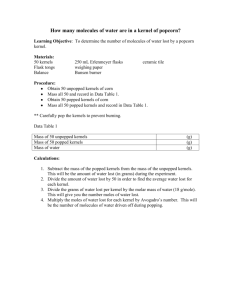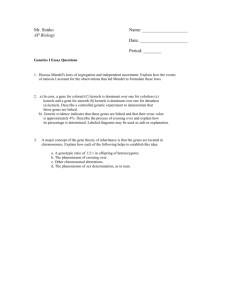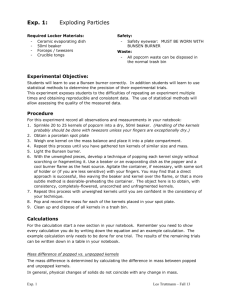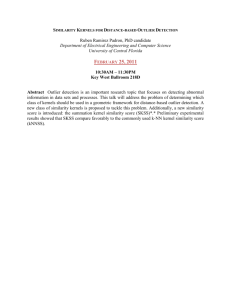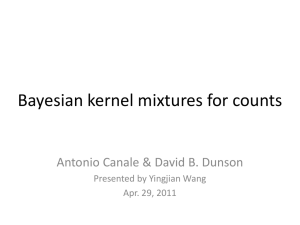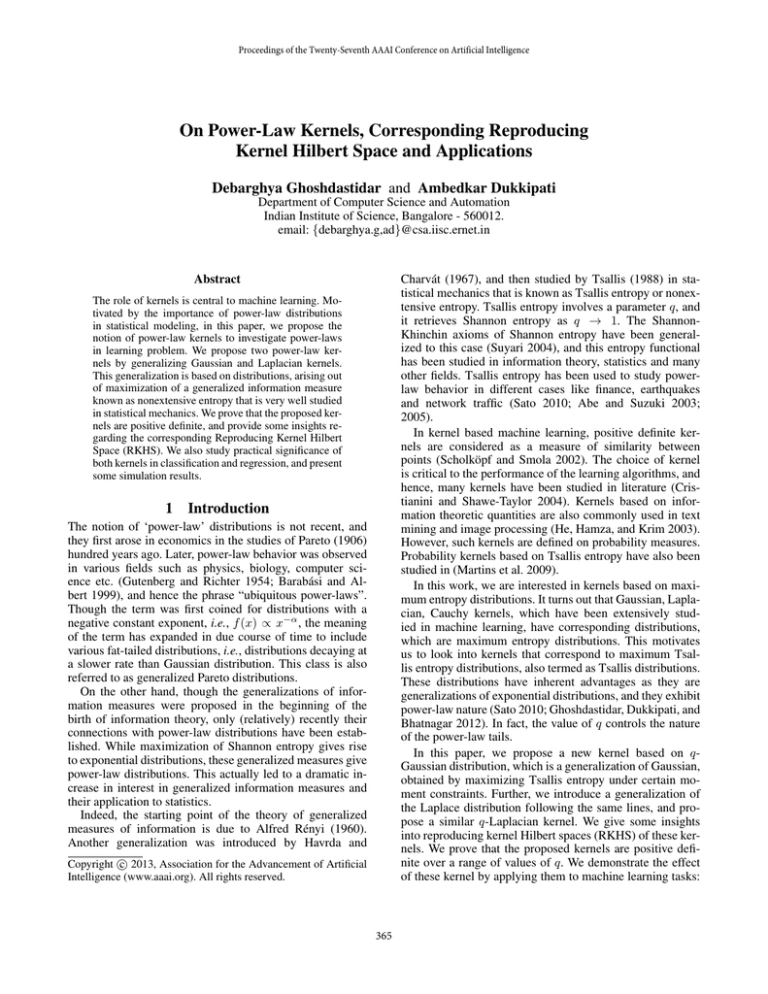
Proceedings of the Twenty-Seventh AAAI Conference on Artificial Intelligence
On Power-Law Kernels, Corresponding Reproducing
Kernel Hilbert Space and Applications
Debarghya Ghoshdastidar and Ambedkar Dukkipati
Department of Computer Science and Automation
Indian Institute of Science, Bangalore - 560012.
email: {debarghya.g,ad}@csa.iisc.ernet.in
Charvát (1967), and then studied by Tsallis (1988) in statistical mechanics that is known as Tsallis entropy or nonextensive entropy. Tsallis entropy involves a parameter q, and
it retrieves Shannon entropy as q → 1. The ShannonKhinchin axioms of Shannon entropy have been generalized to this case (Suyari 2004), and this entropy functional
has been studied in information theory, statistics and many
other fields. Tsallis entropy has been used to study powerlaw behavior in different cases like finance, earthquakes
and network traffic (Sato 2010; Abe and Suzuki 2003;
2005).
In kernel based machine learning, positive definite kernels are considered as a measure of similarity between
points (Scholköpf and Smola 2002). The choice of kernel
is critical to the performance of the learning algorithms, and
hence, many kernels have been studied in literature (Cristianini and Shawe-Taylor 2004). Kernels based on information theoretic quantities are also commonly used in text
mining and image processing (He, Hamza, and Krim 2003).
However, such kernels are defined on probability measures.
Probability kernels based on Tsallis entropy have also been
studied in (Martins et al. 2009).
In this work, we are interested in kernels based on maximum entropy distributions. It turns out that Gaussian, Laplacian, Cauchy kernels, which have been extensively studied in machine learning, have corresponding distributions,
which are maximum entropy distributions. This motivates
us to look into kernels that correspond to maximum Tsallis entropy distributions, also termed as Tsallis distributions.
These distributions have inherent advantages as they are
generalizations of exponential distributions, and they exhibit
power-law nature (Sato 2010; Ghoshdastidar, Dukkipati, and
Bhatnagar 2012). In fact, the value of q controls the nature
of the power-law tails.
In this paper, we propose a new kernel based on qGaussian distribution, which is a generalization of Gaussian,
obtained by maximizing Tsallis entropy under certain moment constraints. Further, we introduce a generalization of
the Laplace distribution following the same lines, and propose a similar q-Laplacian kernel. We give some insights
into reproducing kernel Hilbert spaces (RKHS) of these kernels. We prove that the proposed kernels are positive definite over a range of values of q. We demonstrate the effect
of these kernel by applying them to machine learning tasks:
Abstract
The role of kernels is central to machine learning. Motivated by the importance of power-law distributions
in statistical modeling, in this paper, we propose the
notion of power-law kernels to investigate power-laws
in learning problem. We propose two power-law kernels by generalizing Gaussian and Laplacian kernels.
This generalization is based on distributions, arising out
of maximization of a generalized information measure
known as nonextensive entropy that is very well studied
in statistical mechanics. We prove that the proposed kernels are positive definite, and provide some insights regarding the corresponding Reproducing Kernel Hilbert
Space (RKHS). We also study practical significance of
both kernels in classification and regression, and present
some simulation results.
1
Introduction
The notion of ‘power-law’ distributions is not recent, and
they first arose in economics in the studies of Pareto (1906)
hundred years ago. Later, power-law behavior was observed
in various fields such as physics, biology, computer science etc. (Gutenberg and Richter 1954; Barabási and Albert 1999), and hence the phrase “ubiquitous power-laws”.
Though the term was first coined for distributions with a
negative constant exponent, i.e., f (x) ∝ x−α , the meaning
of the term has expanded in due course of time to include
various fat-tailed distributions, i.e., distributions decaying at
a slower rate than Gaussian distribution. This class is also
referred to as generalized Pareto distributions.
On the other hand, though the generalizations of information measures were proposed in the beginning of the
birth of information theory, only (relatively) recently their
connections with power-law distributions have been established. While maximization of Shannon entropy gives rise
to exponential distributions, these generalized measures give
power-law distributions. This actually led to a dramatic increase in interest in generalized information measures and
their application to statistics.
Indeed, the starting point of the theory of generalized
measures of information is due to Alfred Rényi (1960).
Another generalization was introduced by Havrda and
c 2013, Association for the Advancement of Artificial
Copyright Intelligence (www.aaai.org). All rights reserved.
365
classification and regression by SVMs. We provide results
indicating that in some cases, the proposed kernels perform
better than their counterparts (Gaussian and Laplacian kernels) for certain values of q.
2
is considered, then maximization of Tsallis entropy with
only this constraint leads to a q-variant of the doubly exponential or Laplace distribution centered at zero. A translated
version of the distribution can be written as
|x − μ|
1
expq −
.
(8)
p(x) =
2β
(2 − q)β
Tsallis distributions
Tsallis entropy can be obtained by generalizing the information of a single event in the definition of Shannon entropy
as shown by Tsallis (1988), where natural logarithm is re1−q
placed with q-logarithm defined as lnq x = x 1−q−1 , q ∈ R,
q > 0, q = 1. Tsallis entropy in a continuous case is defined
as (Dukkipati, Bhatnagar, and Murty 2007)
q
p(x) dx
1−
R
Hq (p) =
, q ∈ R, q > 0, q = 1. (1)
q−1
This function retrieves the differential Shannon entropy
functional as q → 1. It is called nonextensive because of
its pseudo-additive nature (Tsallis 1988).
Kullback’s minimum discrimination theorem (Kullback
1959) establishes connections between statistics and information theory. A special case is Jaynes’ maximum entropy
principle (Jaynes 1957), by which exponential distributions
can be obtained by maximizing Shannon entropy functional,
subject to some moment constraints. Using the same principle, maximizing Tsallis entropy under the following constraint
q
x p(x) dx
= μ,
(2)
q-mean xq := R q
p(x) dx
As q → 1, we retrieve the exponential, Gaussian and
Laplace distributions as special cases of (3), (6) and (8),
respectively. The above distributions can be extended to
a multi-dimensional setting in a way similar to Gaussian
and Laplacian distributions, by incorporating 2-norm and 1norm in (6) and (8), respectively.
3
Proposed Kernels
Based on the above discussion, we define the q-Gaussian
kernel Gq : X × X → R, for a given q ∈ R, as
x − y
22
Gq (x, y) = expq −
for all x, y ∈ X , (9)
(3 − q)σ 2
where X ⊂ RN is the input space, and q, σ ∈ R are two
parameters controlling the behavior of the kernel, satisfying
the conditions q = 1, q = 3 and σ = 0. For 1 < q < 3, the
term inside the bracket is non-negative and hence, the kernel
is of the form
1
1−q
(q − 1)
2
x
−
y
,
(10)
Gq (x, y) = 1 +
2
(3 − q)σ 2
where .
2 is the Euclidean norm. On similar lines, we
use (8) to define the q-Laplacian kernel Lq : X × X → R
x − y
1
for all x, y ∈ X , (11)
Lq (x, y) = expq −
(2 − q)β
R
results in a distribution known as q-exponential distribution (Tsallis, Mendes, and Plastino 1998), which is of the
form
x
1
,
(3)
p(x) = expq −
μ
(2 − q)μ
where the q-exponential, expq (z), is expressed as
1
expq (z) = 1 + (1 − q)z +1−q .
(4)
where .
1 is the 1-norm, and q, β ∈ R satisfy the conditions
q = 1, q = 2 and β > 0. As before, for 1 < q < 2, the kernel
can be written as
1
1−q
(q − 1)
Lq (x, y) = 1 +
x − y
1
.
(12)
(2 − q)β
The condition y+ = max(y, 0) in (4) is called the Tsallis
cut-off condition, which ensures existence of q-exponential.
If a constraint based on the second moment,
q
(x − μ)2 p(x) dx
q-variance x2 q := R = σ 2 , (5)
q
p(x) dx
Due to the power-law tail of the Tsallis distributions for
q > 1, in case of the above kernels, similarity decreases
at a slower rate than the Gaussian and Laplacian kernels
with increasing distance. The rate of decrease in similarity
R
is considered along with (2), one obtains the q-Gaussian distribution (Prato and Tsallis 1999) defined as
Λq
(x − μ)2
p(x) = √
expq −
,
(6)
(3 − q)σ 2
σ 3−q
where Λq is the normalizing constant (Prato and Tsallis
1999). However, instead of (2), if the constraint
q
|x| p(x) dx
|x|q := R = β,
(7)
q
p(x) dx
Figure 1: Example plots for (a) q-Gaussian and (b) qLaplacian kernels with σ = β = 1.
R
366
where σ ∈ R, σ > 0. We can retrieve the Gaussian kernel (14) when q → 1 in the q-Gaussian kernel (10). The
Rational Quadratic kernel is of the form
x − y
22
ψ2 (x, y) = 1 −
,
(15)
x − y
22 + c
is controlled by the parameter q, and leads to better performance in some machine learning tasks, as shown later. Figure 1 shows how the similarity decays for both q-Gaussian
and q-Laplacian kernels in the one-dimensional case. It can
be seen that as q increases, the initial decay becomes more
rapid, while towards the tails, the decay becomes slower.
We now show that for certain values of q, the proposed
kernels satisfy the property of positive definiteness, which
is essential for them to be useful in learning theory. Berg,
Christensen, and Ressel (1984) have shown that for any symmetric kernel function K : X × X → R, there exists a mapping Φ : X → H, H being a higher dimensional space,
such that K(x, y) = Φ(x)T Φ(y), for all x, y ∈ X if and
only if K is positive definite (p.d.), i.e., given any set of
points {x1 , x2 , . . . , xn } ⊂ X , the n × n matrix K, such
that Kij = K(xi , xj ), is positive semi-definite.
We first state some of the results presented in (Berg,
Christensen, and Ressel 1984), which are required to prove
positive definiteness of the proposed kernel.
Lemma 1. For a p.d. kernel ϕ : X × X → R, ϕ 0, the
following conditions are equivalent:
1. − log ϕ is negative definite (n.d.), and
2. ϕt is p.d. for all t > 0.
Lemma 2. Let ϕ : X × X → R be a n.d. kernel, which is
strictly positive, then ϕ1 is p.d.
where c ∈ R, c > 0. Substituting q = 2 in (10), we obtain (15) with c = σ 2 . The Laplacian kernel is defined as
x − y
1
,
(16)
ψ3 (x, y) = exp −
σ
where σ ∈ R, σ > 0. We can retrieve (16) as q → 1 in the
q-Laplacian kernel (12).
4
Reproducing Kernel Hilbert Space
As discussed earlier, kernels map the data points to a higher
dimensional feature space, also called the Reproducing Kernel Hilbert Space (RKHS) that is unique for each positive definite kernel (Aronszajn 1950). The significance of
RKHS for support vector kernels using Bochner’s theorem (Bochner 1959), which provides a RKHS in Fourier
space for translation invariant kernels, is stated in (Smola,
Schölkopf, and Müller 1998). Other approaches also exist that lead to explicit description of the Gaussian kernel (Steinwart, Hush, and Scovel 2006), but this approach
does not work for the proposed kernels as Taylor series expansion of the q-exponential function (4) does not converge
for q > 1. So, we follow the Bochner’s approach.
We state Bochner’s theorem, and then use the method presented in (Hofmann, Schölkopf, and Smola 2008) to show
how it can be used to construct the RKHS for a p.d. kernel.
We state the following proposition, which is a general result providing a method to generate p.d. power-law kernels,
given that their exponential counterpart is p.d.
Proposition 3. Given
a p.d. kernel
ϕ : X × X → R of the
form ϕ(x, y) = exp − f (x, y) , where f (x, y) 0 for all
x, y ∈ X , the kernel φ : X × X → R given by
k
(13)
φ(x, y) = 1 + cf (x, y) , for all x, y ∈ X ,
Theorem 6 (Bochner). A continuous kernel ϕ(x, y) =
ϕ(x − y) on Rd is positive definite if and only if ϕ(t) is
the Fourier transform of a non-negative measure, i.e., there
exists ρ 0 such that ρ(ω) is the inverse Fourier transform
of ϕ(t).
is p.d., provided the constants c and k satisfy the conditions
c > 0 and k < 0.
Proof. Since, ϕ is p.d., it follows from Lemma 1 that the
kernel f = − log ϕ is n.d. Thus, for any c > 0, (1 + cf ) is
n.d., and as f 0, we can say (1 + cf ) is strictly positive.
1
So, application of Lemma 2 leads to the fact that (1+cf
) is
p.d. Finally, using Lemma 1, we can claim (1 + cf )k is p.d.
for all c > 0 and k < 0.
Then, the RKHS of the kernel ϕ is given by
⎫
⎧
∞
⎬
⎨
ˆ(ω)|2
|
f
Hϕ = f ∈ L2 (R)
dω < ∞
⎭
⎩
ρ(ω)
(17)
−∞
From Proposition 3 and positive definiteness of Gaussian
and Laplacian kernels, we can show that the proposed qGaussian and q-Laplacian kernels are p.d. for certain ranges
of q. However, strikingly, it turns out that over this range, the
kernels exhibit power-law behavior.
Corollary 4. For 1 < q < 3, the q-Gaussian kernel, as
defined in (10), is positive definite.
Corollary 5. For 1 < q < 2, the q-Laplacian kernel, as
defined in (12), is positive definite for all β > 0.
Now, we show that some of the popular kernels can be
obtained as special cases of the proposed kernels. The Gaussian kernel is defined as
x − y
22
,
(14)
ψ1 (x, y) = exp −
2σ 2
with the inner product defined as
∞ ˆ
f (ω)ĝ(ω)
f, gϕ =
dω,
ρ(ω)
(18)
−∞
where fˆ(ω) is the Fourier transform of f (t) and L2 (R) is set
of all functions on R, square integrable with respect to the
Lebesgue measure.
It must be noted here that in our case, the existence and
non-negativity of the inverse Fourier transform ρ is obvious due to the positive definiteness of the proposed kernels
(Corollaries 4 and 5). Hence, to describe the RKHS it is
enough to determine an expression for ρ for both the kernels.
367
(q−1)
where c = (3−q)σ
2 . Each of the cosine term can be expanded
in form of an infinite series as
2m 2m
∞
ω j j tj j
.
(−1)mj
cos(tj ωj ) =
(2mj )!
m =0
We define the functions corresponding to the q-Gaussian and
q-Laplacian kernels, respectively, as
1
⎞ 1−q
⎛
N
(q − 1)
t2 ⎠
, q ∈ (1, 3),
ϕG (t) = ⎝1 +
(3 − q)σ 2 j=1 j
j
Substituting in (23) and using Lemma 7, we obtain
1
ρG (ω) = √
N 1 ×
2πc Γ q−1
(19)
and
⎛
1
⎞ 1−q
N
(q
−
1)
|tj |⎠
,
ϕL (t) = ⎝1 +
(2 − q)β j=1
q ∈ (1, 2),
(20)
where β, σ ∈ R, β > 0 and t = (t1 , . . . , tN ) ∈ RN . We derive expressions for their inverse Fourier transforms ρG (ω)
and ρL (ω), respectively. For this, we require a technical result (Gradshteyn and Ryzhik 1994, Eq. 4.638(3)), which is
stated in the following lemma.
Lemma 7. Let s ∈ (0, ∞) and pi , qi , ri ∈ (0, ∞) for i =
1, 2, . . . , N be constants, then the N -dimensional integral
N pi −1
∞ ∞
∞
i=1 xi
s dx1 dx2 . . . dxN
...
N
0
0
0
1 + i=1 (ri xi )qi
⎛ ⎞
N
N
Γ pqii
Γ s − i=1 pqii ⎝ pq ⎠ .
=
Γ(s)
q i ri i i
i=1
m1 ,..,mN =0
1
− 2
c
N
j=1
mj
Γ
N
1
N −
−
mj g(ω)
q−1
2
j=1
(24)
where
2m
N
ωj j Γ mj + 12
g(ω) =
.
(2mj )!
j=1
(25)
Using expansion of gamma function for half integers, we
can write (25) as
2m
N
ωj j
.
(26)
4mj mj !
j=1
N
Substituting in (24) and using b = j=1 mj , we have
g(ω) = π N/2
1
×
ρG (ω) = √ N 1
2c Γ q−1
b ∞ 1
−1
N
−
−
b
Γ
4c2
q−1
2
We now derive the inverse Fourier transforms. We prove
the result for Proposition 8. The proof of Proposition 9 proceeds similarly.
Proposition 8. The inverse Fourier transform for ϕG (t) is
given by
1
ρG (ω) = √
N ×
2(q−1)
1
Γ
2
(3−q)σ
q−1
2b
∞
b
1
(3 − q)σ 2 ω
2
(−1)
N
Γ
−
−b
.
b!
q−1
2
2(q − 1)
b=0
(21)
Proof. By definition,
−N/2
ρG (ω) = (2π)
exp(it · ω)ϕG (t)dt .
(22)
b=0
m1 ,..,mN
N
mk =b
k=1
2mN
ω12m1 ...ωN
m1 !...mN !
(27)
We arrive at the claim by observing that the terms in the
inner summation in (27) are similar to terms of multinomial
2 b
expansion of b!1 ω12 + . . . + ωN
.
It can be observed that the above result agrees with the
fact that inverse Fourier transform of radial functions are
radial in nature. We present corresponding result for qLaplacian kernel.
Proposition 9. The inverse Fourier transform for ϕL (t) is
given by
1
ρL (ω) = √
N ×
π(q−1)
1
√
Γ q−1
(2−q)β 2
2b
∞
(2 − q)β
1
− N − 2b
(−1)b Γ
gb (ω),
q−1
(q − 1)
b=0
(28)
RN
Expanding the exponential term, we have
N
cos(tj ωj ) + i sin(tj ωj ) .
exp(it · ω) =
j=1
Since, both cos(tj ωj ) are ϕG (t) are even functions for every
tj , while sin(tj ωj ) is an odd function, hence integrating over
RN , all terms with a sin component become zero. Further,
the remaining term is odd, and hence, the integral is same in
every orthant. So the expression reduces to
ρG (ω) =
1
N2 ∞ ∞ 1−q
N
N
2
2
1+c
..
tj
cos(tj ωj )dt1 ...dtN
π
j=1
j=1
0
∞
where
gb (ω) =
2mN
ω12m1 ω22m2 . . . ωN
m1 ,...,mN ∈N
N
mk =b
k=1
0
(23)
with ω1 , . . . , ωN being the components of ω.
368
(29)
5
Performance Comparison
In this section, we apply the q-Gaussian and q-Laplacian
kernels in classification and regression. We provide insights
into the behavior of these kernels through examples. We also
compare the performance of the kernels for different values of q, and also with the Gaussian, Laplacian (i.e., when
q → 1), and polynomial kernels using various data sets from
UCI repository (Frank and Asuncion 2010). The simulations
have been performed using LIBSVM (Chang and Lin 2011).
Table 1 provides a description of the data sets used. The last
few data sets have been used for regression.
1
2
3
4
5
6
7
8
9
10
11
12
13
Data Set
Acute Inflammations
Australian Credit∗
Blood Transfusion
Breast Cancer∗
Iris
Mammographic Mass
Statlog (Heart)∗
Tic-Tac-Toe
Vertebral Column
Wine∗
Auto MPG
Servo
Wine Quality (red)
Class
2
2
2
2
3
2
2
2
3
3
–
–
–
Attribute
6
14
4
9
4
5
13
9
6
13
8
4
12
Instance
120
690
748
699
150
830
270
958
310
178
398
167
1599
Figure 2: Decision boundaries using (a) Gaussian, (b) qGaussian (q = 2.95), (c) Laplacian, and (d) q-Laplacian
(q = 1.95) kernel SVMs.
SVM are shown in Table 2. Further, the power-law nature
reminds practitioners of the popular polynomial kernels
d
Pd (x, y) = xT y + c ,
for x, y ∈ RN ,
where the parameters c ∈ (0, ∞) and d ∈ N. Hence, we also
provide the accuracies obtained using these kernels. We have
fixed particular σ for each data set, and consider β is fixed at
β = σ 2 . For polynomial kernels, we consider c = 0, while d
is varied. The best values of q among all Gaussian type and
Laplacian type kernels are marked for each data set. In case
of the polynomial kernels, we only mark those cases where
the best results among these kernels is better or comparable
with the best cases of Gaussian or Laplacian types. We note
here that in the simulations, the polynomial kernels required
normalization of few other data sets as well.
The results indicate the significance of tuning the parameter q. For most cases, the q-Gaussian and q-Laplacian kernels tend to perform better than their exponential counterparts. This can be justified by the flexibility of the separating hyperplane achieved. However, it has been observed (not
demonstrated here) that for very high or very low values of
σ (or β), the kernels give similar results, which happens because the power-law and the exponential natures cannot be
distinguished in such cases. The polynomial kernels, though
sometimes comparable to the proposed kernels, rarely improves upon the performance of the power-law kernels.
Table 1: Data Sets (sets marked ∗ have been normalized).
5.1
Kernel SVM
Support Vector Machines (SVMs) are one of the most important class of kernel machines. While linear SVMs, using
inner product as similarity measure, are quite common, other
variants using various kernel functions, mostly Gaussian, are
also used in practice. Use of kernels leads to non-linear separating hyperplanes, which sometimes provide better classification. Now, we formulate a SVM based on the proposed
kernels. For the q-Gaussian kernel (10), it leads to an optimization problem with the following dual form:
n
n
1 xi − xj 22
min
αi −
αi αj yi yj expq −
α∈Rn
2 i,j=1
(3 − q)σ 2
i=1
n
subject to αi 0, i = 1, . . . , n, and i=1 αi yi = 0,
where, {x1 , . . . , xn } ⊂ X are the training data points and
{y1 , . . . , yn } ⊂ {−1, 1} are the true classes. The optimization problem for theq-Laplaciankernel (12) can be formuxi −xj 1
lated by using expq − (2−q)β
in the above expression.
The two-dimensional example in Figure 2 illustrates the
nature of hyperplanes that can be obtained using various kernels. The decision boundaries are more flexible for
q-Laplacian and q-Gaussian kernels. Further, viewing the
Laplacian and Gaussian kernels as special cases (q → 1),
it can be said that increase in the value of q leads to more
flexibility of the decision boundaries.
We compare the performance of the proposed kernels with
Gaussian and Laplacian kernel SVMs for various values of
q. The results of 5-fold cross validation using multiclass
5.2
Kernel Regression
In linear basis function models for regression, given a set of
data points, the output function is approximated as a linear
combination of fixed non-linear functions as f (x) = w0 +
M
j=1 wj φj (x), where {φ1 (.), . . . , φM (.)} are the basis
functions, usually chosen as φj (x) = ψ(x, xj ), x1 , . . . , xM
being the given data points, and ψ a p.d. kernel. The constants {w0 , w1 , . . . , wM } are obtained by minimizing least
squared error. Such an optimization can be formulated as an
-Support Vector type problem (Smola and Schölkopf 2004).
369
Polynomial
q-Laplacian
q-Gaussian
Data Sets √
Parameter (σ = β)
Gaussian (q → 1)
q = 1.25
q = 1.50
q = 1.75
q = 2.00
q = 2.25
q = 2.50
q = 2.75
q = 2.95
Laplacian (q → 1)
q = 1.25
q = 1.50
q = 1.75
q = 1.95
d = 1 (linear)
d=2
d=5
d = 10
1
10
86.67
86.67
86.67
88.33
88.33
89.17
91.67
98.33
100
93.33
95.83
97.50
100
100
100
100
100
100
2
15
76.96
82.46
83.19
86.38
85.80
85.51
85.51
85.51
85.51
86.23
85.51
85.51
85.51
85.51
85.51
85.22
80.72
76.23
3
5
77.27
77.14
76.87
76.60
76.74
76.60
76.34
76.47
75.53
77.81
77.94
77.27
77.14
75.67
72.86
76.47
76.47
76.47
4
5
96.63
96.63
96.93
96.93
96.93
96.93
96.93
97.22
97.22
97.07
97.07
97.07
97.51
97.80
97.07
96.19
95.61
94.00
5
2
97.33
97.33
97.33
98.00
98.00
98.00
97.33
96.67
96.67
96.67
96.67
96.67
96.67
96.00
98.00
96.67
95.33
94.67
6
25
79.28
79.40
79.52
79.76
79.88
79.40
80.00
80.48
80.12
81.69
81.57
81.81
82.29
83.73
82.17
83.86
83.61
81.69
7
5
82.96
82.96
83.33
83.33
83.33
83.33
84.07
84.07
82.22
83.70
83.70
83.70
83.33
82.96
83.70
80.37
74.81
74.81
8
1.5
89.46
89.25
89.25
88.94
88.62
87.68
85.49
84.34
75.99
94.89
92.80
89.67
84.55
71.09
65.34
86.53
94.15
88.73
9
50
87.10
87.10
87.10
86.45
86.13
85.48
85.48
85.16
85.16
76.45
77.42
77.10
78.39
86.77
85.16
76.77
64.84
59.03
10
1
97.19
97.19
97.75
97.75
97.75
98.31
98.31
98.31
97.75
98.88
98.88
98.88
98.88
95.51
97.19
96.63
94.94
93.26
Table 2: Percentage of correct classification in kernel SVM using 5-fold cross validation.
Data Sets √
Parameter (σ = β)
Gaussian (q → 1)
q = 1.25
q = 1.50
q = 1.75
q = 2.00
q = 2.25
q = 2.50
q = 2.75
q = 2.95
Laplacian (q → 1)
q = 1.25
q = 1.50
q = 1.75
q = 1.95
d = 1 (linear)
d=2
d=5
d = 10
q-Laplacian
q-Gaussian
The kernels defined in (10) and (12) can also be used in
this case as shown in the example in Figure 3, where -SV
regression is used to reconstruct a sine wave from 20 uniformly spaced sampled data points in [0, π].
Polynomial
Figure 3: Sine curve obtained by -SVR using Gaussian, qGaussian (q = 2.95),
√ Laplacian and q-Laplacian (q = 1.95)
kernels with σ = β = 2 and = 0.01.
The performance of the proposed kernels have been compared with polynomial, Gaussian and Laplacian kernels for
various values of q using data sets 11, 12 and 13. The results of 5-fold cross validation using -SVR ( = 0.1) are
shown in Table 3. We fixed particular β = σ 2 for each data
set. Though Laplacian kernel seems to outperform its powerlaw variants, the q-Gaussians dominate the performance of
Gaussian kernel. The results further indicate that the error is
a relatively smooth function of q, and does not have a fluctuating behavior, though its trend seems to depend on the data.
The relative performance of the polynomial kernels is poor.
6
11
1
11.1630
11.0694
10.9674
10.8826
10.7406
10.5661
10.4428
10.4796
12.2427
9.7681
10.2052
10.9578
13.2213
17.7303
13.3765
10.5835
16.8173
52.4609
12
2
0.9655
0.9218
0.9035
0.8986
0.9005
0.9072
0.9424
1.0698
1.5439
0.5398
0.5532
0.6055
0.7910
1.6934
1.9047
2.2740
2.3305
2.7358
13
10
0.4916
0.4883
0.4853
0.4823
0.4781
0.4734
0.4661
0.4595
0.4419
0.4298
0.4223
0.4123
0.3961
0.3784
0.4357
0.4268
0.5485
10.5518
Table 3: Mean Squared Error in kernel SVR.
nential counterparts, which in turn broadens the use of these
kernels in learning tasks.
We showed that the proposed kernels are positive definite
for certain range of q, and presented results pertaining to the
RKHS of the proposed kernels using Bochner’s theorem. We
also demonstrated the performance of the proposed kernels
in support vector classification and regression.
The power-law behavior was recognized long time back
in many problems in the context of statistical analysis. Recently power-law distributions have been studied in machine
learning communities. As far as our knowledge, this is the
first paper that introduces and studies power-law kernels,
leading to the notion of a “fat-tailed kernel machine”.
Conclusion
In this paper, we proposed a power-law generalization of
Gaussian and Laplacian kernels based on Tsallis distributions. They retain their properties in the classical case as
q → 1. Further, due to their power-law nature, the tails of
the proposed kernels decay at a slower rate than their expo-
370
References
theoretic kernels on measures. Journal of Machine Learning
Research 10:935–975.
Pareto, V. 1906. Manuale di economica politica. Societa
Editrice Libraria.
Prato, D., and Tsallis, C. 1999. Nonextensive foundation of
Lévy distributions. Physical Review E. 60(2):2398–2401.
Rényi, A. 1960. Some fundamental questions of information theory. MTA III. Oszt. Közl. 10:251–282. (reprinted
in (Turán 1976), pp. 526-552).
Sato, A. H. 2010. q-Gaussian distributions and multiplicative stochastic processes for analysis of multiple financial time series. Journal of Physics: Conference Series
201(012008).
Scholköpf, B., and Smola, A. J. 2002. Learning with Kernels. MIT Press.
Smola, A. J., and Schölkopf, B. 2004. A tutorial on support
vector regression. Statistics and computing 14(3):199–222.
Smola, A. J.; Schölkopf, B.; and Müller, K. 1998. The connection between regularization operators and support vector
kernels. Neural Networks 11:637–649.
Steinwart, I.; Hush, D. R.; and Scovel, C. 2006. An explicit description of the reproducing kernel Hilbert spaces of
Gaussian RBF kernels. IEEE Transactions on Information
Theory 52(10):4635–4643.
Suyari, H. 2004. Generalization of Shannon-Khinchin axioms to nonextensive systems and the uniqueness theorem
for the nonextensive entropy. IEEE Transactions on Information Theory 50:1783–1787.
Tsallis, C.; Mendes, R. S.; and Plastino, A. R. 1998. The
role of constraints within generalized nonextensive statistics. Physica A: Statistical Mechanics and its Applications
261(3):534–554.
Tsallis, C. 1988. Possible generalization of BoltzmannGibbs statistics. Journal of Statiscal Physics 52(1-2):479–
487.
Turán, P., ed. 1976. Selected Papers of Alfréd Rényi. Budapest: Akademia Kiado.
Abe, S., and Suzuki, N. 2003. Itineration of the internet over
nonequilibrium stationary states in Tsallis statistics. Physical Review E 67(016106).
Abe, S., and Suzuki, N. 2005. Scale-free statistics of time
interval between successive earthquakes. Physica A: Statistical Mechanics and its Applications 350:588–596.
Aronszajn, N. 1950. Theory of reproducing kernels. Transactions of American Mathematical Society 68(3):337–404.
Barabási, A. L., and Albert, R. 1999. Emergence of scaling
in random networks. Science 286:509–512.
Berg, C.; Christensen, J. P. R.; and Ressel, P. 1984. Harmonic Analysis on Semigroups: Theory of Positive Definite
and Related Functions. Springer.
Bochner, S. 1959. Lectures on Fourier Integral. Princeton
N.J.: Princeton University Press.
Chang, C. C., and Lin, C. J. 2011. LIBSVM: A library for
support vector machines. ACM Transactions on Intelligent
Systems and Technology 2(3):27:1–27:27.
Cristianini, N., and Shawe-Taylor, J. 2004. Kernel methods
for Pattern Analysis. Cambridge University Press.
Dukkipati, A.; Bhatnagar, S.; and Murty, M. N. 2007.
On measure-theoretic aspects of nonextensive entropy functionals and corresponding maximum entropy prescriptions.
Physica A: Statistical Mechanics and its Applications
384(2):758–774.
Frank, A., and Asuncion, A.
2010.
UCI Machine Learning Repository.
University of California,
Irvine, School of Information and Computer Sciences:
http://archive.ics.uci.edu/ml.
Ghoshdastidar, D.; Dukkipati, A.; and Bhatnagar, S. 2012.
q-Gaussian based smoothed functional algorithms for
stochastic optimization. In International Symposium on Information Theory. IEEE.
Gradshteyn, I. S., and Ryzhik, I. M. 1994. Table of Integrals,
Series and Products (5th ed.). Elsevier.
Gutenberg, B., and Richter, C. F. 1954. Seismicity of the
Earth and Associated Phenomena (ed. 2). Princeton, NJ:
Princeton University Press.
Havrda, J., and Charvát, F. 1967. Quantification method
of classification processes: Concept of structural a-entropy.
Kybernetika 3(1):30–35.
He, Y.; Hamza, A. B.; and Krim, H. 2003. A generalized divergence measure for robust image registration. IEEE Transactions on Signal Processing 51(5):1211–1220.
Hofmann, T.; Schölkopf, B.; and Smola, A. J. 2008. Kernel methods in machine learning. Annals of Statistics
36(3):1171–1220.
Jaynes, E. T. 1957. Information theory and statistical mechanics. The Physical Review 106(4):620–630.
Kullback, S. 1959. Information theory and statistics. N.Y.:
John Wiley and Sons.
Martins, A. F. T.; Smith, N. A.; Xing, E. P.; Aguiar, P. M. Q.;
and Figueiredo, M. A. T. 2009. Nonextensive information
371


